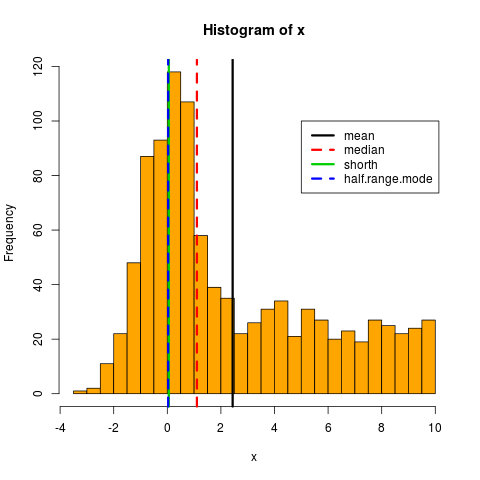Supported by Dr. Osamu Ogasawara and  providing providing  . . |
|
Last data update: 2014.03.03 |
A location estimator based on the shorthDescriptionA location estimator based on the shorth Usageshorth(x, na.rm=FALSE, tie.action="mean", tie.limit=0.05) Arguments
DetailsThe shorth is the shortest interval that covers half of the
values in Ties: if there are multiple shortest intervals,
the action specified in Rate of convergence: as an estimator of location of a unimodal distribution, under regularity conditions, the quantity computed here has an asymptotic rate of only n^{-1/3} and a complicated limiting distribution. See ValueThe mean of the Author(s)Wolfgang Huber http://www.ebi.ac.uk/huber, Ligia Pedroso Bras References
See Also
Examples
x = c(rnorm(500), runif(500) * 10)
methods = c("mean", "median", "shorth", "half.range.mode")
ests = sapply(methods, function(m) get(m)(x))
if(interactive()) {
colors = 1:4
hist(x, 40, col="orange")
abline(v=ests, col=colors, lwd=3, lty=1:2)
legend(5, 100, names(ests), col=colors, lwd=3, lty=1:2)
}
Results
R version 3.3.1 (2016-06-21) -- "Bug in Your Hair"
Copyright (C) 2016 The R Foundation for Statistical Computing
Platform: x86_64-pc-linux-gnu (64-bit)
R is free software and comes with ABSOLUTELY NO WARRANTY.
You are welcome to redistribute it under certain conditions.
Type 'license()' or 'licence()' for distribution details.
R is a collaborative project with many contributors.
Type 'contributors()' for more information and
'citation()' on how to cite R or R packages in publications.
Type 'demo()' for some demos, 'help()' for on-line help, or
'help.start()' for an HTML browser interface to help.
Type 'q()' to quit R.
> library(genefilter)
> png(filename="/home/ddbj/snapshot/RGM3/R_BC/result/genefilter/shorth.Rd_%03d_medium.png", width=480, height=480)
> ### Name: shorth
> ### Title: A location estimator based on the shorth
> ### Aliases: shorth
> ### Keywords: arith
>
> ### ** Examples
>
>
> x = c(rnorm(500), runif(500) * 10)
> methods = c("mean", "median", "shorth", "half.range.mode")
> ests = sapply(methods, function(m) get(m)(x))
>
> # if(interactive()) {
> colors = 1:4
> hist(x, 40, col="orange")
> abline(v=ests, col=colors, lwd=3, lty=1:2)
> legend(5, 100, names(ests), col=colors, lwd=3, lty=1:2)
> # }
>
>
>
>
>
> dev.off()
null device
1
>
|
